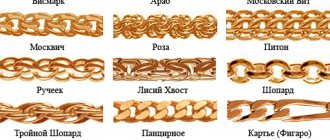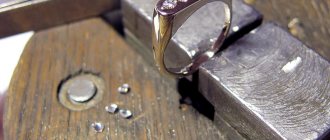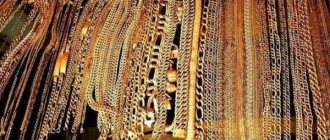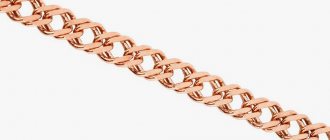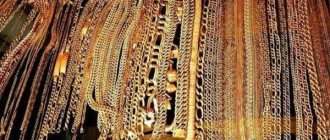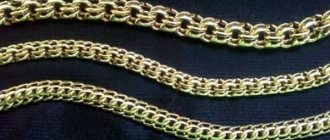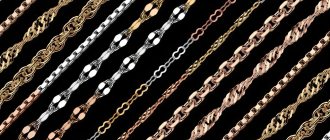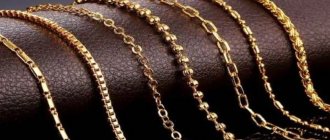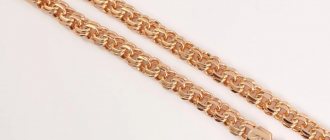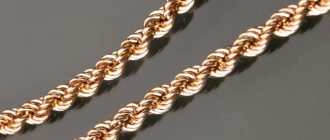A neck chain or body chain is a popular accessory. In order for it to always remain loved, it is worth at least a little understanding of the techniques for making it.
There are three types of chain manufacturing technology: machine knitting , hand weaving and stamping . However, it does not follow from this that any chain can be made in all three ways. Each method has its own specifics, strengths and weaknesses. Some weaves can only be done in one specific way. For example, most varieties of complex Bismarck are made by hand. Thin, lightweight chains weighing about one gram are almost always made using machine knitting. Stamping makes it possible to create amazing fantasy jewelry with links of various shapes, but they will look a little voluminous. The cost of chains depends on many factors, but often hand chains, which require more time to produce, are more expensive than similar machine chains.
Machine knitting chains
Light chains from very thin links by machine . Modern chain knitting machines are capable of producing products from wire with a thickness of 0.15 mm.
When making gold chains of anchor weave, the machine creates 600 links per minute. The finished chains are calcined in ovens by heating to 815 ° C in order to activate a special agent that solders the ends of the links. The quality of a machine-woven chain depends on the accuracy of the technological processes. The technological process of machine-made chains is illustrated by a video that can be viewed in the section on machine knitting in our article on types of chain weaving.
Nuances of choice
When visiting a jewelry store, some women (and sometimes men) get wide-eyed. There are many options on display, and an ignorant person will simply be confused. It is recommended to immediately pay attention to the quality of the material, its shine and the strength of the connection of the links. Even if you choose the most durable type of weaving, unpleasant situations associated with the craftsman’s dishonesty are possible.
You should definitely check the lock. It can be carbine or springel . The first one is usually suitable for massive, heavy products, provides a strong fastening, and eliminates the possibility of spontaneous opening and loss of the chain. The second has a round shape, usually used for thin, elegant, hollow chains.
When choosing, it is worth noting the size of the hole on the selected pendant. The eye of the lock should pass through it freely, so that the owner can independently put on and, if necessary, change the pendant to another.
It is recommended to pay attention to the length of the product. For women, chains of 40-50 cm are suitable, for men it is better to choose an option from 55-60 cm or more. The indicator depends on the purpose of the chain and the use of additional accessories.
An important point - before purchasing, it is recommended to try on the jewelry, feel it on your neck, and listen to your feelings. If you experience discomfort, it is better to choose another option.
Hand knitting chains
Handmade chains are considered the most reliable. Of course, if we are talking about the high professionalism of jewelers, because it is their skill that affects the durability and beauty of the product. For example, the correct selection of the diameter of the crossbar (a tool for leveling the shape of the ring) and the thickness of the wire determine whether the chain links will break or bend poorly. Such defects cannot be corrected. Hand weaving is used not only in small workshops, but also in large industries. In this way, chains weighing from six grams .
The history of ancient jewelry
Today we do not know for certain where the craftsman who first came up with the idea of making links from precious metal and connecting them together lived. It is unknown what his name was. One thing is certain: this happened a very, very long time ago. After all, fashionable gold chains first appeared at almost the same time in Ancient Greece and Ancient Egypt. True, at that time, only a massive chain, which only very wealthy men could afford, was considered “fashionable” at that time.
It is believed that sun worshipers decorated themselves with items made of yellow metal to respect the deity and become like him. And noble citizens of Greece and Egypt, as evidenced by excavations, were always buried in full vestment: it included, among other things, the heaviest gold chains.
As time passed, representatives of the fair half of humanity chose “male” jewelry. Then the stylish gold chain became much thinner and lighter and, in general, came closer to the look that we know now. At the same time, the girls’ imagination ran wild, and women’s chains began to be worn not only as a separate piece of jewelry, but also as a basis for a pendant. And besides, such an accessory began to be worn not only on the neck, but also on the arm, leg, and even woven into the hairstyle.
Our closest ancestors also had their own chest decorations. For example, until the 13th century in Rus' it was fashionable to decorate oneself with so-called “pendants”. This was the name for amulets made of metal or stone, which were suspended on a chain.
Interestingly, the fashion for a particular link shape was very variable. And only after a long time were the most popular geometric shapes from which chain links were made determined. These were:
- rings;
- ovals;
- squares;
- diamonds.
The question of how to make chains was simply not asked then: only by hand. Of course, our ancient ancestor did not yet know any machines or mechanisms, and therefore each piece of jewelry was made by a goldsmith - a chain maker. This is also why the chain was perceived as a very expensive accessory. Very few could afford to pay the cost of the precious metal and the services of a chain maker, so in the Middle Ages such jewelry remained an unchanged symbol of wealth and high position in society.
As often happens, machine labor is valued much less than manual labor. And therefore, the advent of chain knitting machines partially solved the problem of the exorbitant cost of gold jewelry.
France was the first country in which machine chain knitting was put on stream. During the French Revolution (and this is the end of the 18th century), a machine for weaving chains was first manufactured. It greatly simplified the production of jewelry and made it cheaper. It’s interesting that the basis for the first machine was… a sewing machine. Specialists sought to make the machine repeat the movements of a person, a master, only, of course, doing it faster and more perfectly.
Over time, companies appeared that specialized in the manufacture of such chain knitting machines. The business became profitable, and everyone benefited: machine tool manufacturers, jewelers, and end consumers.
Availability and prestige
Actually, only in the middle of the last century did gold jewelry become available to many people. A variety of accessories made from the main precious metal decorated the images of fashionistas and fashionistas. And although today gold chains are deprived of the status that they had ten centuries ago, they still remain a prestigious and sought-after decoration. There may be several reasons for this.
- Symbolism of the circle. No matter how modern people we consider ourselves to be, somewhere deep in the subconscious many people still believe in signs that were important to our distant ancestors. The circle in the minds of the ancients is a symbol of the ideal and the most powerful amulet. And the chain consists of many small circles-links that wrap around the neck in a large circle. The chain is therefore a protection. Albeit on a subconscious level.
- Symbolism of the gold metal. Gold is a symbol of the Sun. Remember how often in winter or on cloudy days we lack the warmth and light of our sun. Gold, the “representative of the Sun on Earth,” can replenish the lack of energy in the body, recharge you and give you optimism and success.
- Versatility. There is no person who would not like a gold chain. There are simply no such people. Thin, thick, simple, fancy, short, long - the choice is truly endless.
- Compatibility. This accessory looks great on a person of any gender, age, build, or social status. The chain advantageously sets off dark and pale skin, light or dark hair, blue or brown eyes. And most importantly, it goes perfectly with any clothes - without exception!
- Durability. Provided you purchase a quality product and use it carefully, the chain will serve faithfully not only to you, but to your children and grandchildren. Least.
Stamped chains
When stamping, the links of the chain are threaded into each other (assembled), rather than soldered. The links themselves are made using special cutting dies, which are used to press sheet metal. The thickness of the metal is no more than 0.3 mm. Externally, stamped products look slightly voluminous and heavier than their actual weight. Stamping is a fairly simple and fast way to make chains, much cheaper than hand weaving.
However, stamped jewelry is very capricious when worn. They are easy to deform and difficult to repair. Therefore, it is recommended to remove them before going to bed.
The most popular types of chain weaving
Today there are many varieties of knitting gold chains. According to various sources, there are from 50 to 70 of them! But nevertheless, all jewelry is divided into three large types (everything else is subtypes and subtypes).
- Made using the Bismarck technique , such jewelry has no equal in durability. This is due to manufacturing technology. To achieve such reliability, craftsmen manually connect the link elements to each other in different directions. And then the finished links are soldered together quite closely, forming a “dense” chain. The most popular subspecies here are:
- "American";
- "Arab Bismarck"
- "Italian";
- "python".
- "double diamond";
- "spikelet";
- "lav";
- "nonna";
- "rhombus";
- "snake"
- "figaro".
- "garibaldi";
- "double anchor";
- "rollo".
Hollow chains - how are they produced?
The technological process of manufacturing hollow chains (some people habitually call them “blown”), which are now experiencing the peak of their popularity, is quite complex technologically. To obtain a high-quality product that can be worn every day without risking deformation, special equipment and careful adherence to technology are required.
The main advantage of hollow chains is that they look very large (and large jewelry is now in fashion!), but they are noticeably lighter in weight than their solid counterparts, which leads to their quite affordable cost.
The “empty body” inside such a chain is achieved thanks to a core of base metal (for example, iron). The core (the middle of iron) is wrapped with a plate of precious metal, and then etched with acid (read more about metal etching technology). By the way, if the technology is not followed, then iron residues inside the gold wire can significantly “lower” the declared quality of the product. After etching the core on hollow chains, a barely noticeable seam remains, but with high-quality production, jewelers will ensure that it is always on the inside of the chain link.
The process of producing hollow jewelry is similar to a conventional machine or manual one. The wire is rolled (thinned) and annealed to align the structure of the metal grains. The chain links are soldered. If necessary, hollow chains are diamond cut and hammered (see chapter below). And at the very last stage, the core is etched.
Hollow chains should be worn as carefully as possible - if a link becomes deformed, it is usually impossible to restore or repair the chain.
Differences and production
Regardless of the type of weaving, chains can be divided into solid and hollow . The first ones are a massive decoration that does not have emptiness inside. Its weight is quite large, but this does not affect the ease of wearing in everyday life. In addition, they are very resistant to mechanical damage. If the integrity is damaged, a specialist can easily replace one or more links.
The latter do not differ in appearance from solid ones. Only by comparison can one determine that in one’s hands there is a hollow product, much lighter in weight. Its cost is several times lower, so such chains are quite popular.
More recently, all chains were made by hand, requiring the utmost concentration of the jeweler, a lot of time and effort. The first stage of production was melting the gold in the required quantity. After this, miniature rings were made from the material. Using special tools, they were joined together to create a piece of jewelry. Since metal was hardly cleaned in those days, the jewelry was carefully polished to a shine before being put up for sale.
Today, handmade products are valued much higher than machine-made ones. There are some types that can only be done by hand if you have the appropriate knowledge and experience.
The machine can also produce beautiful and durable chains. Some types of equipment even work with links as small as 2 mm. Thanks to the automation of the process, the resulting products are attractively priced. The cost depends on weight, measured in grams.
The main disadvantage of automated production is considered to be the low strength of the chain and the inability to produce jewelry using some types of weaving. The advantage of the method is the production of a large batch in a short time, the low cost of the final product.
Further processing: diamond cutting and hammered chains
The appearance of a chain already made using one of the methods can be changed, sometimes almost beyond recognition. This is done by processing the product. One popular option is the diamond cut (or “diamond”, as jewelers lovingly call it). This procedure is carried out on a special machine for applying a diamond facet(s). To make diamond-cut chains sparkle more, the chamfer can be removed from almost all sides of the chain link - external and internal. At the output of the link, there are several faces (reflective surfaces) - for example, 6, 8 or more. Typically, diamond cutting is used on armored chains and Bismarcks.
Another popular type of chain processing is the so-called “chipping”. The assembled chains of various weaves differ markedly from the “parent” weave, and provide an almost endless variety of types of chains. The essence of the knocking technology is to calibrate the thickness and width of the links. In more understandable terms, the chain is compressed on a special press with different forces, due to which its geometry changes. Press dies for chopping can give chains various cross-sectional shapes - round, rectangular, etc. The compression force is similar to that of up to 30 tons of pressure and the resulting chains become very dense and rigid, which must be taken into account when choosing a suitable chain.
Where to buy jewelry
JEWELIRUMA catalog - an updated selection of interesting jewelry brands with search filters | Where to buy designer jewelry - review of sites | Seven brands of premium jewelry presented in Russia | The main exhibitions and sales of jewelry and designer costume jewelry
JEWELRY - CHAINS
What types of neck chains are there? | How to choose a suitable chain? | What types of weaving do chains have? | How to clean a chain? | Waist and body chains | Children's neck chains - how to choose? | Men's neck chains
Share this article with your friends
Works by designers from the JEWELIRUM catalog
- Co.Cos Jewelry
- Co.Cos Jewelry
- Taiga Jewelry, Tomsk
- Taiga Jewelry, Tomsk
- Ilya Maksimov, Crimea
- Ilya Maksimov, Crimea
- UBIRING
- UBIRING
- Diamonds are Forever
- Diamonds are Forever
- Rings in natural style, Sergacheva Jewelery
- Earrings with pearls, Sergacheva Jewelery
- Cabochon ring, Minty Sky
- Fly earrings, Minty Sky
- Ring, Precious Park
- Ring, Precious Park
- Snake skin ring, Stoyanova Jewelery
- Chain earrings, Stoyanova Jewelery
- Children's pendant - stick, Matthew&Daniel
- Pendant for a child, Matthew&Daniel
- Bracelet, Svetlana Subbotina
- Ring with Slavic symbols, Svetlana Subbotina
- Indian style ring, Anna Goffman
- Indian style ring, Anna Goffman
- Earrings, ISTA
- Geometric ring, ISTA
- Earrings with enamel, PNJewelry
- Ring with enamel, PNJewelry
- Ring, Khramtsova Jewelry
- Ring, Khramtsova Jewelry
- Wedding rings to order, obruchalki.com
- Wedding rings to order, obruchalki.com
- Earrings, Yuri Bylkov
- Earrings, Yuri Bylkov
- Titanium bracelets, LanaMuransky
- Titanium pendant, LanaMuransky
- Brooch Elephant (after Salvador Dali), THING
- Ring Veil, THING
- Mace earrings, VLADIMIR MARKIN
- Cufflinks, jewelry mechanics, VLADIMIR MARKIN
- Drop-shaped ring, EKATERINA TOLSTAYA
- Drop-shaped earrings, EKATERINA TOLSTAYA
- Necklace with amber, LETA
- Earrings with amber, LETA
- Children's earrings, combinable, FASHBY
- Children's earrings, combinable, FASHBY
- Ring of architectural form, Elizaveta Malafeevskaya MANU_L
- Architectural bracelet, Elizaveta Malafeevskaya MANU_L
- Set Ginkgo Leaf, SHABUT JEWELLERY
- Brooch Wearable porcelain, SHABUT JEWELLERY
- Architectural ring, GEOMETRY
- Brooch, porcelain, GEOMETRY
- Necklace made of polymer clay, LICORNE ART
- Brooch made of polymer clay, LICORNE ART
- Ring, avant-garde, VALERY SEREDIN
- Bracelet, avant-garde. VALERY SEREDIN
- Wooden set, Scandinavian/Japanese minimalism, VLADIMIR SHESTAKOV
- Ring, Scandinavian/Japanese minimalism, VLADIMIR SHESTAKOV
- Earrings, TON ANT
- Ring, TON ANT
- Architectural ring, ANCHOR
- Architectural necklace, ANCHOR
- Earrings, GOHFELD JEWELLERY
- Necklace, GOHFELD JEWELLERY
- Massive ring, YAKISCHIK
- Designer jewelry, YAKISCHIK
- Architectural ring, ONE DAY ART
- Architectural ring, ONE DAY ART
- Brooch, bionics, VALERIYA MARKOVA (TESSA)
- Unclosed ring, bionics, VALERIYA MARKOVA (TESSA)
- Ring, bionics, BEAVERS
- Earrings, bionics, BEAVERS
- Earrings, asymmetry, VAGANOVA JEWELRY
- Airplane ring, VAGANOVA JEWELRY
- Flower ring, ALCHEMIA JEWELLERY
- Set, ALCHEMIA JEWELLERY
- Pendant-cat, ethnic, STUDIO OF ILYA AND VERA PALKIN
- Earrings, STUDIO OF ILYA AND VERA PALKIN
How to buy a jewelry chain that will last for many years?
Probably, almost every one of us has faced the desperate question of how and where gold chains break. Sometimes the reasons are obvious: you suddenly caught the chain on something, pulled, pulled - and that’s it: the jewelry is hopelessly damaged. However, it is not a fact that it is hopeless. For example, there are craftsmen who know how to make a bracelet or other jewelry from a gold chain. But this is not always possible. And therefore, it is better to pay attention to five important factors when buying jewelry:
- how strong the weave of a particular chain is;
- what knitting method is chosen for its manufacture;
- Is the lock placed on the decoration of high quality;
- are there any sharp points, creases or other flaws atypical for a quality product;
- Does the manufacturer provide a warranty for its own product?
The strongest chains
The main characteristic of a strong chain is simplicity. The simpler the design of the jewelry, the less likely it is to become deformed or torn. And, just as important, the easier it is to repair the product if necessary. And finally, it will cost much less.
Therefore, if it is important for you to wear a chain regularly, and not decorate yourself with it from time to time, pay attention to the most durable weaving. What can you choose and what can you refuse?
- Stamped and hollow chains are definitely not your option. They are easily deformed and difficult to repair.
- The champion in strength is Bismarck weaving. This is exclusively hand-knitted, therefore, when purchasing such a chain, you need to be sure of the qualifications of the jeweler. There is simply nothing stronger and more reliable than this weaving. True, sometimes “Bismarck” is considered a rough knit, too brutal for sophisticated ladies. In this case, do not be upset. There is still a lot of elegant yet durable jewelry in the world.
- Pay attention to the chains made with “anchor” weaving. It is durable in itself, and can also be easily repaired if necessary. All the technician needs to do is replace or solder the broken link. Among the universal “anchor” weaves, we can recommend “Venetian”, “garibaldi” or “spikelet”.
- Armor weaves are considered quite durable. For the most part, they're comfortable to wear and don't get tangled, which means they're less likely to tear. For men, a massive figaro chain would be an excellent option. Such jewelry is also easy to repair and comfortable to wear. But for ladies we can recommend the attractive “nonna”.
Weaving "Spider"
Spider weaving is made using a similar technology. The machine simultaneously passes wire through 5 links.
Venetian weaving of gold chains is made on a different machine (see video). The wire is placed in a special channel, in which mechanical clamps bend it around the shape, connecting it to the previous link.
Gold chains are wonderful jewelry that is suitable not only for women, but also for men. Learning how to make a gold chain with your own hands is a great idea for a jewelry maker. A gold chain is a luxurious piece of jewelry that attracts the attention of people around you, and for a jeweler, chains provide a wide scope for the embodiment of fantasies and creativity.
It often happens that the chain breaks easily, although it does not look so fragile. It is impossible to even imagine that this chain can support the weight of a weight. Why does this happen? In this article we will try to understand and answer this question. To begin with, let’s take a general look at all the stages of making gold chains.
The jeweler takes a small bar of pure gold, which was obtained after refining. Separates the required amount and mixes it with the ligature. This is done to ensure that the gold chain is strong and durable. To obtain the necessary alloy for making a chain, you need to take 5.85 grams of pure gold, 2.92 grams of copper and 1.22 grams of silver.
We melt all these metals in a crucible, sprinkle with borax, and be sure to stir. The melting point is about 950 degrees. After hardening, the hot piece of metal is cooled in water and boiled in bleach. As a result, we get 10 grams of 585 gold alloy, which indicates the percentage of gold in the product.
The higher the purity, the higher the pure gold content, but the much softer the alloy. Impurities of other metals not only impart hardness and strength to gold, but also change its color. By replacing the ratio of metals that make up the ligature, the required color for the future decoration is selected.
To make a chain, we pour gold into a mold and get a gold rod about 5 mm thick. In order to make a chain from it, you now need to burn it and stretch it to the wire diameter, which depends on the mass of the future product.
To do this, you need to pass our rod first through rollers, from a larger stream to a smaller one, and then through dies. When rolling on rollers, it is very important not to confuse the size of the strand, since if you put a gold rod into a strand of a smaller size, cracks will appear, and as a result, when pulled through dies, the wire will break and the future product will be of poor quality. When working with dies, it is necessary to lubricate the wire with the wax of a regular candle.
After completing the stage of making gold wire, the process of weaving the chain itself begins. First of all, the resulting gold wire is twisted into a spiral of the required diameter, then from the spiral, using special scissors, we cut links for the future chain. We weave the resulting links into a chain of the required length and solder them using solder. Next comes the process of polishing and installing the lock.
How to solder gold at home?
Soldering gold step by step will look like this:
- we prepare or buy solder suitable for the required gold standard;
- apply flux beyond the boundaries of the soldering area and wait until it spreads over the surface;
- you will need to get a fevka - a bent tube with a hole at the end to supply a narrow jet of flame from the burner;
- we join the parts to be soldered and after heating them, introduce solder;
- After cooling, remove excess solder using a needle file.
This type of soldering can be done independently. If the work is done carefully, no seam should be visible in a small area.
The magic of hand-made masterpieces
No matter how beautiful factory-made gold jewelry may be, hand-woven chains will always have the status of a unique, aristocratic exclusive. Each such product retains the warmth of the master’s hands and his energy, so do not contact the first jeweler you come across. First, make inquiries about him, find out how the chains he created are worn, whether the fate of their owners has changed for the better or for the worse.
Don't believe in mysticism? Then just look at the samples of chains, evaluate the quality and choose the one whose design you like the most. A jeweler may recommend one or another weave, depending on what purpose the jewelry will serve: to emphasize the seriousness of a business suit, to highlight the luxury of an evening dress, to complement a democratic style of clothing.
You will be surprised, but custom-made hardware chains cost an order of magnitude higher than handmade ones. They are closer to the standards, which means they are more durable and reliable. You can bring your own gold and pay only for the work - very convenient if you have a sufficient amount of scrap gold at home. For each chain, the master selects his own mode of operation of the machine, carefully checking each link so that the chain turns out perfect.
Gold chains presented in jewelry stores are not so expensive due to the highly automated production at manufacturing plants. A streamlined scheme for creating chains allows you to reduce the time spent on weaving and, accordingly, reduce the cost of the product. By the way, large jewelry stores provide the opportunity to exchange gold scrap for a finished product, paying extra only for the work and the missing grams.
Before purchasing a chain, check it for smoothness and absence of burrs, make sure that it has a sample and the manufacturer's mark, and test the strength of the lock. We hope that your new gold jewelry, regardless of who made it - a person or a machine, will delight you for many years.
How to make a bead chain with your own hands?
The hook picks up the wire thread and pulls it up. The previous loop is pulled out. Thus, two air loops were formed. The next loop is also pulled through. The wire is picked up from the bottom and pulled to the air loop.
Viking knit is an ancient way of weaving a chain that does not require soldering of the links. The chain in this technique is woven from a long piece of wire, which is extended as needed.
The name can be translated into Russian roughly as “Viking knots” or “Viking weaving”. The technique received this name due to the fact that the first decoration of this type was found in a Viking burial. But then there were other, more ancient finds, and now it is believed that the technique originally came from the city of Trichipoli in India. I use this chain for antique style jewelry.
How to Wear Gold Chains
True, even a thorough check of the product before purchasing does not give a 100% guarantee of its “indestructibility” if you do not follow the simple rules of wearing jewelry and caring for it. What rules are we talking about?
Wearing a chain without taking it off for many years is not a good idea. Believe me, if suddenly your jewelry breaks for no reason, there is no point in tormenting the Internet with the question of why a gold chain breaks. You, of course, will be given thousands of answers (the main ones indicate the presence of the evil eye or damage to you). But in fact, such a situation cannot be called “out of the blue”! You wore the jewelry without taking it off, slept in it, went to the gym and shower, cleaned the apartment and wandered through the forest - and you never know what else! And so, day after day, year after year, the links in the chain gradually frayed, unable to withstand your “extreme” living conditions. And at first glance, of course, the chain broke “just like that.”
Contact with household chemicals and various detergents and cleaning substances is considered no less harmful for gold jewelry. Gold comes into contact very easily with chlorine, iodine and bromine. Therefore, it is probably a very smart idea to remove the chain before swimming in the pool. And don’t put it on when you decide to refurbish your apartment.
But what won’t harm the chain is reasonable and careful care. It's not complicated! Of course, from time to time you can wash the jewelry yourself in warm soapy water, then rinse in cold water and polish it with a soft cloth. But perhaps a more reasonable solution would be to have your jewelry cleaned by a specialist. He guarantees you that he will use soft, gentle cleaning agents that will not leave even micro-scratches on the product. Still, progress does not stand still, and folk remedies are gradually giving way to professional cleaning. It's probably for the better. At the very least, regular cleaning and preventative maintenance is the key to ensuring that your favorite piece of jewelry will serve you for many years without losing its visual appeal.
Choosing a high-quality, beautiful chain is not an easy task. After all, reliability and aesthetics should be merged in it as harmoniously as possible. Wear jewelry for a long time and comfortably and look your best in it - who can say what is more important today? And is it necessary to choose? Once you learn how gold chains are made, you will be able to choose a product for yourself with greater ease. After all, now all the secret behind the scenes of jewelry production is open to you. We are confident that you will be able to make good use of the information you have!

